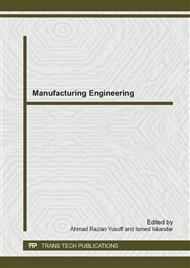p.67
p.73
p.78
p.83
p.90
p.96
p.102
p.108
p.114
Experimental Investigation on Friction Coefficient of Engineering Polymers Sliding against Different Counterface Materials
Abstract:
In this research, friction coefficients of engineering polymers such as nylon and polytetrafluoroethylene (PTFE) are investigated under normal load and sliding velocity. Experiments are conducted when nylon and PTFE slide against different counterface pin materials such as mild steel and stainless steel 202 (SS 202). Experiments are carried out at different normal loads 2, 4 and 6 N, and sliding velocities 0.2, 0.4 and 0.6 m/s. Results show that in general, friction coefficient of nylon decreases with the increase in normal load and sliding velocity. On the other hand, during friction process, PTFE shows different trend i.e. friction coefficient of PTFE increases with the increase in normal load and sliding velocity. Moreover, it is observed that at identical operating conditions, the values of friction coefficient of nylon and PTFE are different depending on normal load, sliding velocity and counterface material.
Info:
Periodical:
Pages:
90-95
Citation:
Online since:
February 2014
Keywords:
Price:
Сopyright:
© 2014 Trans Tech Publications Ltd. All Rights Reserved
Share:
Citation:


